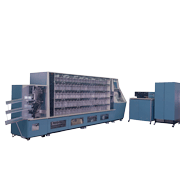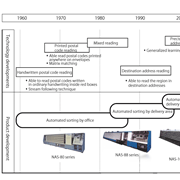Published on Mar. 18, 2020
Last updated on Aug. 23, 2023
The NAS-5 automatic postal code reading and sorting machine was developed by NEC in 1968 and was evaluated in actual sorting operations at the Omiya Post Office in October of that year. The commercial version of NAS-5B model (with 100 sorting slots) was delivered to the Shinjuku Post Office in June 1969. The table below gives an overview of NAS-5B.
The primary specifications of NAS-5B automatic postal code reading and sorting machine:| Parameter | Specification |
|---|---|
| External dimensions | Main unit: 4,300 x 1,000 x 1,800 mm (w x d x h) Auxiliary accumulator unit: 800 x 850 x 1,150 mm (w x d x h) Sorter 1: 1,000 x 750 x 1,300 mm (w x d x h) Sorter 2: 750 x 850 x 1,700 mm (w x d x h) |
| Sorting slots | 100, three more on the auxiliary accumulator unit |
| Actual maximum processing speed | 20,000 mail items per hour |
| Mail items handled | Standard size mail items Length: 140 to 235 mm Width: 90 to 120 mm Thickness: 0.2 to 6.0 mm |
| Reading codes | First three digits of postal codes Note: Postal codes at the time consisted of five digits: three digits separated by hyphen from two final digits |
| Power supply | 200 VAC, three-phase four-line system |
| Power consumption | 12 kVA |
【History of mail sorters】
NEC developed a sorter in 1968, which read the three digits of postal codes and separated mail items into the different slots corresponding to the destination post offices. In around 1980, the NAS-80 series recognized the postal codes printed on mailing labels and realized to read mail items with handwritten and printed postal codes mixed. In 1989, the NAS-88 series implemented to read destination addresses of flexible handwritten characters, using the multi-stage elasticity comparison technology originally developed by NEC, and address recognition processing together. In 1994, NEC had developed high-precision mail OCR machines using generalized learning vector quantization (GLVQ) and address character tagging technologies in order to read entire postal addresses. These machines could read not only town names and street addresses but also apartment building names and room numbers with high precision detail.
《Notes》
Multi-stage elasticity comparison technology : the individual character recognition technology to adjust expansion and contraction parts using dynamic programming methods, adopting direction characteristics and gradation/displacement shadings of an character.
Generalized learning vector quantization (GLVQ) technology: the NEC original technology to automatically generate character recognition dictionaries (standard patterns) to identify characters and figures.
Address character tagging technology : the address identification technology utilizing character selection candidates and knowledge processing, using a character or left- / right-hand side part of a character as the fundamental component.



